Ricet (ričet) is a hearty, traditional barley soup that has no rival in the Slovenian culinary heritage. Nothing compares to a bowl of comforting barley soup that captures the warmth and flavors of this enchanting region.
Slovenia is a country known for its stunning natural beauty and equally captivating food culture. Ričet, an iconic dish with barley, was cooked on the eastern side of the Alps as early as the 8th century BC.
When we talk about comfort food, there’s something truly special about a perfectly made bowl of rustic soup. But when that soup also brings the deep flavors of a cherished culinary heritage, it transforms into more than just a meal.
Because ričet certainly isn’t just a meal; it’s a tradition passed down through generations, offering a taste of history and a glimpse into Slovenian everyday life. It’s deeply rooted in the heart of Slovenian culinary tradition.
The perfect combination of vegetables, the tender bite of barley, and the scent of smoked pork all come together in this simple and soul-satisfying stew.
In this blog post, we’ll guide you through the steps to recreate the magic of ričet in your own kitchen, allowing you to savor a piece of Slovenia no matter where you come from.
Ričet through history – how the famous barley soup became a legacy
Ričet (spelled as richet), locally also called “ješprenj,” stands firmly through history as a Slovenian culinary treasure; a rustic, hearty one-pot stew served in a bowl is often recognized simply by its star ingredient – barley.
Although some sources claimed that ričet was invented by the Romans, the roots of this hearty and flavorful creation extend even further into history, with its origins tracing back to the eighth century BCE.
Archaeologists have proven that people were preparing ričet using almost the same recipe during the Iron Age. In Hallstatt, it was cooked with broad beans instead of beans, and they were apparently adding millet and wild garlic to season the ancient stew.
Ričet was first mentioned in 1485 by an Italian jurist Paolo Santonino in his report about dishes in Zilje Valley. Later it was described with the name “ruetschart” in the Bavarian cookbook Klosterkochbuch von Tegernsee in 1534.
In the seventeenth century, a Slovenian natural historian and polymath Janez Vajkard Valvasor (1641-1693), a fellow of the Royal Society in London, mentioned it in his works, using the term characteristic of central Slovenia – “ričet.”
At the time, ričet was eaten in the villages as well as it was often on the menu in the cities. In the old days, women used to cook ričet in large cast-iron pots and cauldrons in wood-fired brick ovens. Ričet was served the next day, and just before serving, they would season it with vinegar and dress it with oil.
An interesting fact related to ričet was the name of a group of mountaineering enthusiasts who called themselves “ričetarji” (or richetars). As ričet can be easily preserved and reheated, they used to hang out over barley bowls on their journeys to the mountain tops. Even today, ricet is still cooked and served in most Slovenian mountain huts.

Ričet will make you fall in love
Like other traditional food recipes, often cooked by Slovenians, like sataraš, authentic beef goulash, buckwheat bread with walnuts and sweet empanada cookies, ričet is another traditional culinary gem that will enchant you no matter where you come from.
Ričet can be, or better to say, should be prepared in advance. The hearty bowl of barley soup will taste even better the next day. It will last up to four days in the refrigerator, and it can also be frozen or canned. This makes it an extraordinary tasty dish with a touch of ancient history that will pop up on your table whenever you’re in a hurry. And truly, there’s nothing better than a jar of canned ričet in your backpack when hiking in the wild.
It can be your secret healthy energy booster, perfectly packed with nutrients, proteins, fibers, minerals and vitamins. Barley contains complex carbohydrates that are broken down gradually, providing a steady release of energy over time. No matter if you are headed to the mountains or preparing to chop a full truck of firewood, the sustained energy release from barley will keep you going a long way.
It also contains a fair amount of iron, which is essential for oxygen transport in the blood and crucial for maintaining energy levels and preventing fatigue. Besides that, it’s loaded with beta-glucans.
I guess you now imagine why ričet is often cooked in the mountains.
Lastly, ričet is like an extraordinary cozy delight in a bowl. The warmth and the savory goodness make it a perfect companion for chilly days. This rustic barley soup is the ultimate comfort food, soothing both body and soul.
It’s worth mentioning that throughout history, ričet was often cooked without any meat. And guess what? The taste of vegan ričet is still genuine; you would be surprised how good it can taste.
Ingredients for a traditional bowl of ričet

BARLEY – We used about two cups of hulled and processed barley seeds, known as barley porridge. Barley has a low glycemic index and is rich in fiber. Its slow energy release will keep you going for a long time. It is believed to lower cholesterol levels, aid digestion, and is a very good source of niacin, the protector of the heart.
Barley porridge needs to be soaked ideally three hours before cooking ričet, or the time of cooking will be much longer.
BEANS – In the traditional recipe, dried brown beans were used and soaked overnight before cooking. However, if you don’t have time to soak the beans, use canned ones and add them to the pot right before the ričet is finally cooked.
SMOKED MEAT – There’s a saying in Slovenia that if a pig doesn’t step in the pot, ričet won’t be right.
Although vegetarian ričet was often cooked by poor people, the traditional recipe calls for variations of smoked pork meat, like pork ribs or homemade Carniolan sausages.
POTATO – Potato is cooked in a lot less time than barley and other vegetables in ričet; that’s why the diced potatoes are added to the pot as last, about half an hour before the end of cooking.
Cooked potatoes will add a little creaminess to the soup and make it taste even sweeter.
KOHLRABI – Kohlrabi is a super-flexible veggie that’s a great addition to soups and was always used in the traditional ričet recipe. It’s a distant cousin of cabbage and comes in pale green or purple skin.
Once cooked, it turns tender but still keeps a nice crunch, giving your soup a little extra flavor. Plus, it’s got a gentle, sweet taste that really gets along with the other ingredients, making your bowl of ričet taste even better. As a bonus, it’s packed with good-for-you stuff like vitamins and minerals.
CARROT – Long before refrigerators and freezers came to life, carrots and other root vegetables were often stored in sand. This way, people could create a cool, dark, and stable environment that extended their shelf life. It allowed them to use them during the winter months when growing conditions were unfavorable and access vegetables during times when fresh produce was scarce. Or during winter months when growing conditions were unfavorable.
Carrots deliver a delightful sweetness and a subtle earthy undertone to the taste of ričet.
CELERY ROOT – Celery root (or celeriac), with its slightly nutty flavor, brings a hint of freshness and depth to the ricet bowl.
PARSLEY ROOT – Similarly to celeriac, parsley root will brighten the earthy flavors in ričet. Besides that, parsley root is a fairly unknown nutritional bomb, rich in vitamin C, folate, fiber, zinc, potassium, phosphorus and magnesium. The parsley root holds three to four times more essential oil than the leaves.
PARSLEY LEAVES – Fresh parsley was used in the recipe, although in winter times, you can use the dried one. There’s quite a high amount of parsley in the traditional ričet. It pairs harmoniously with other ingredients. In fact, I had never tried a dish where parsley would be so pleasantly fused with other aromas than in ričet.
MARJORAM & BAY LEAF – The marjoram contributes a delicate, slightly sweet and floral undertone, while the bay leaves bring a subtle earthy and herbal note. Both will help to prevent bloating and stomach gas caused by cooked beans.
SALT & BLACK PEPPER – Ričet, with its traditional ingredients, is so full of flavor that it needs no other spices except salt and black pepper.
OIL OR LARD – In the old days, lard was often used to stir-fry onions and garlic. Instead of that, you can use olive or sunflower oil as well.
TOMATO (optional) – Tomato was probably not used in the original recipe as the introduction of tomatoes to Europe was facilitated by the Spanish during their colonization of the Americas in the 15th or 16th century. It first came to Italy, where it was grown as an ornamental plant.
However, some people love the taste of tomato in ricet and add it to the simmering soup together with other vegetables.
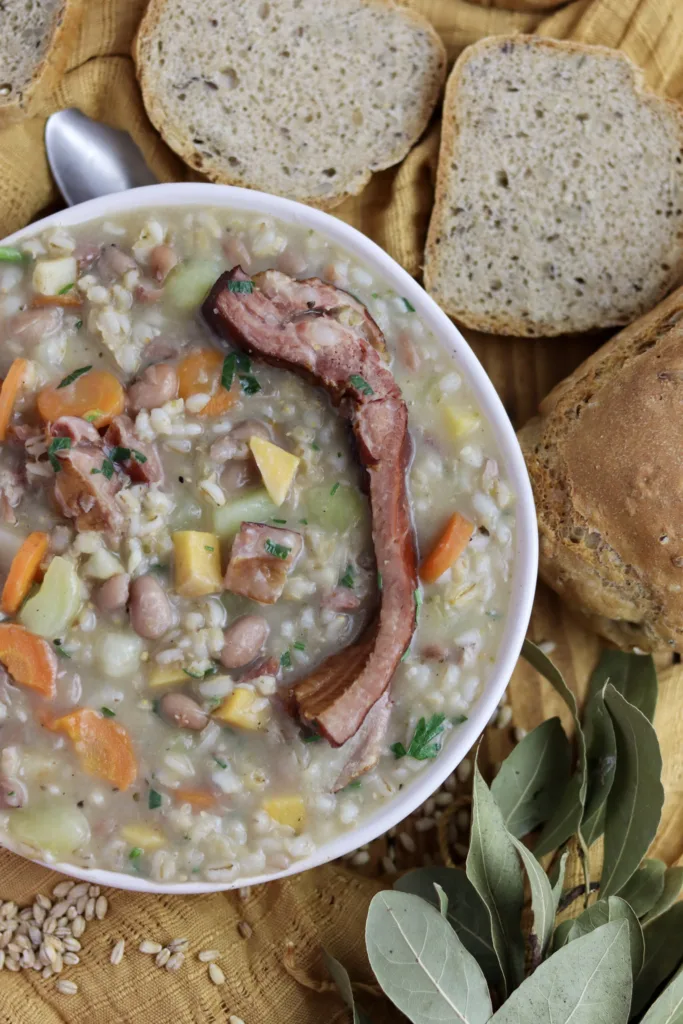
Traditional ričet recipe
SOAK THE BEANS AND BARLEY
STEP 1: The night before, gather the beans, check if all look good and healthy and wash them. Next, place them in a pot big enough and add a double amount of water. The beans should be completely covered with water.
They need to soak for at least eight hours, preferably overnight.
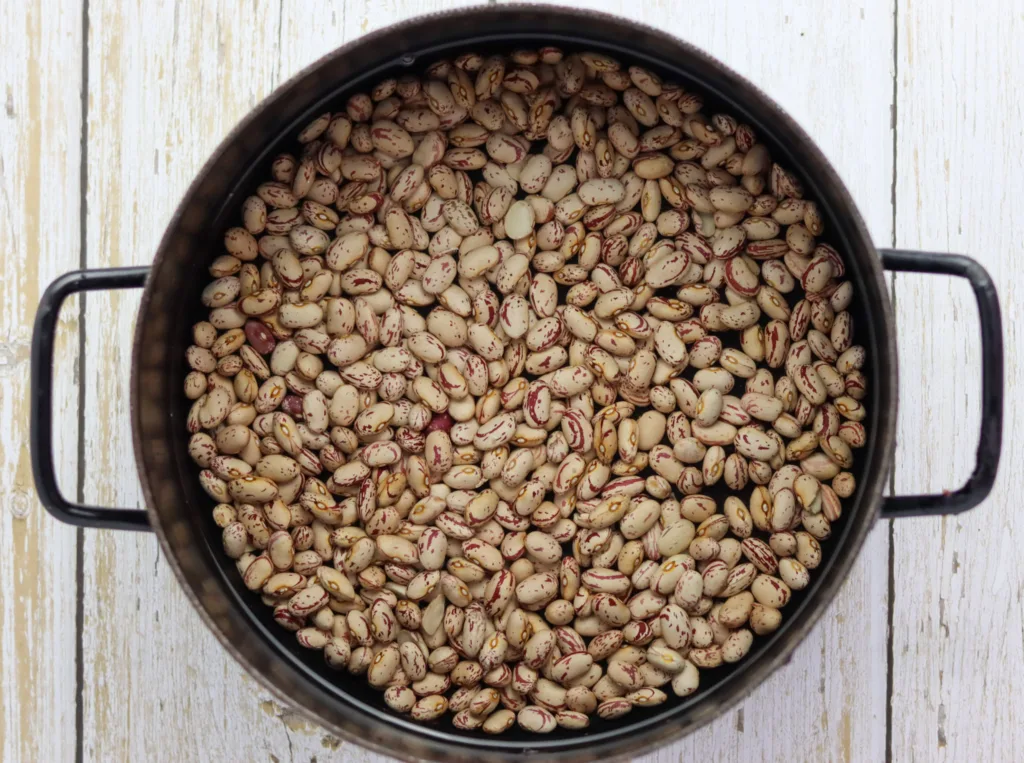
STEP 2: Next day, before you plan to cook ricet, wash barley and also soak it in a pot covered with water for about three hours.
STEP 3: Wash the beans once again and cover them with fresh water. Cook them separately, together with a lavender leaf (or two), until the beans become tender to your liking. Using lavender leaves when cooking beans will help to reduce stomach bloating.
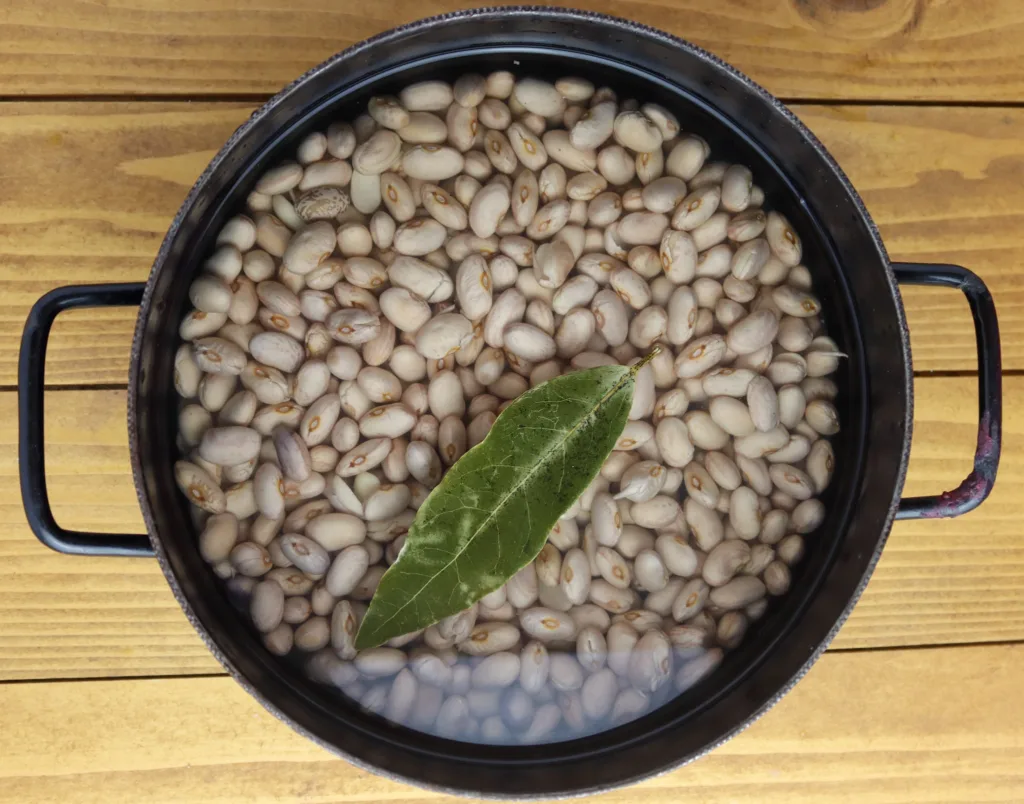
The cooking time for dried beans depends on their age and soaking time, making it hard to pinpoint exactly. The best way is to taste them towards the end of cooking, but definitely, you shouldn’t cook them for more than an hour.
COOK BARLEY WITH PORK RIBS


STEP 4: When the barley is soaked enough, transfer it together with the water in which it was soaking to a bigger pot.
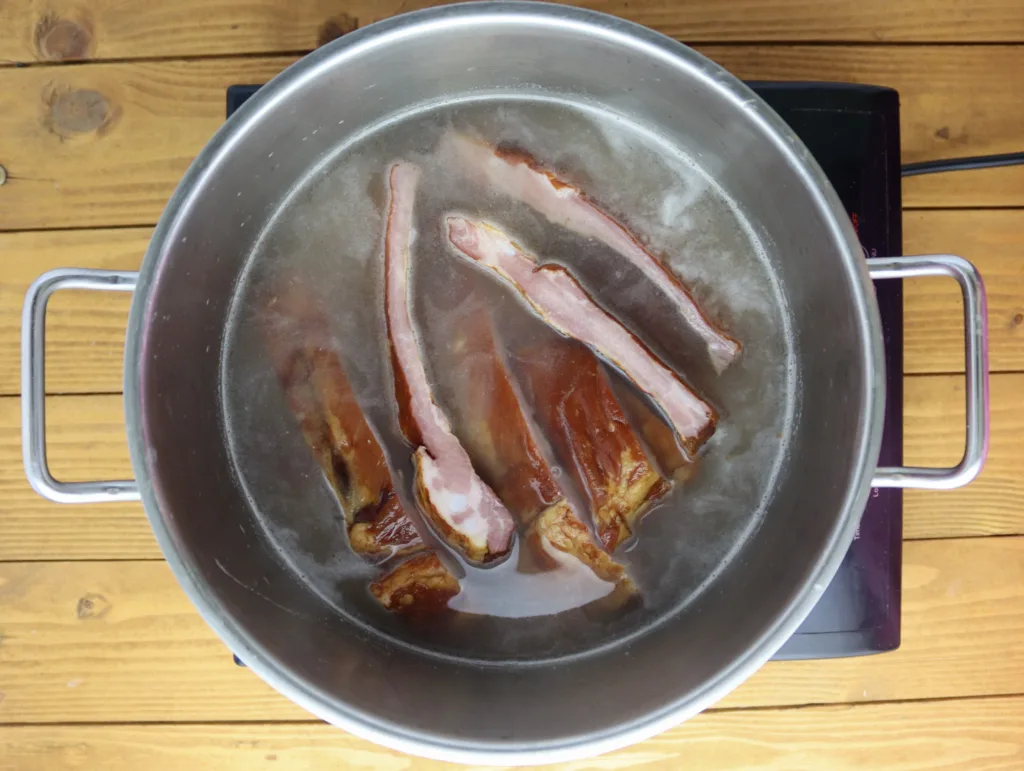
Add smoked pork ribs to the pot, add water that all ingredients are generously covered with, bring to a boil and slowly simmer for an hour.
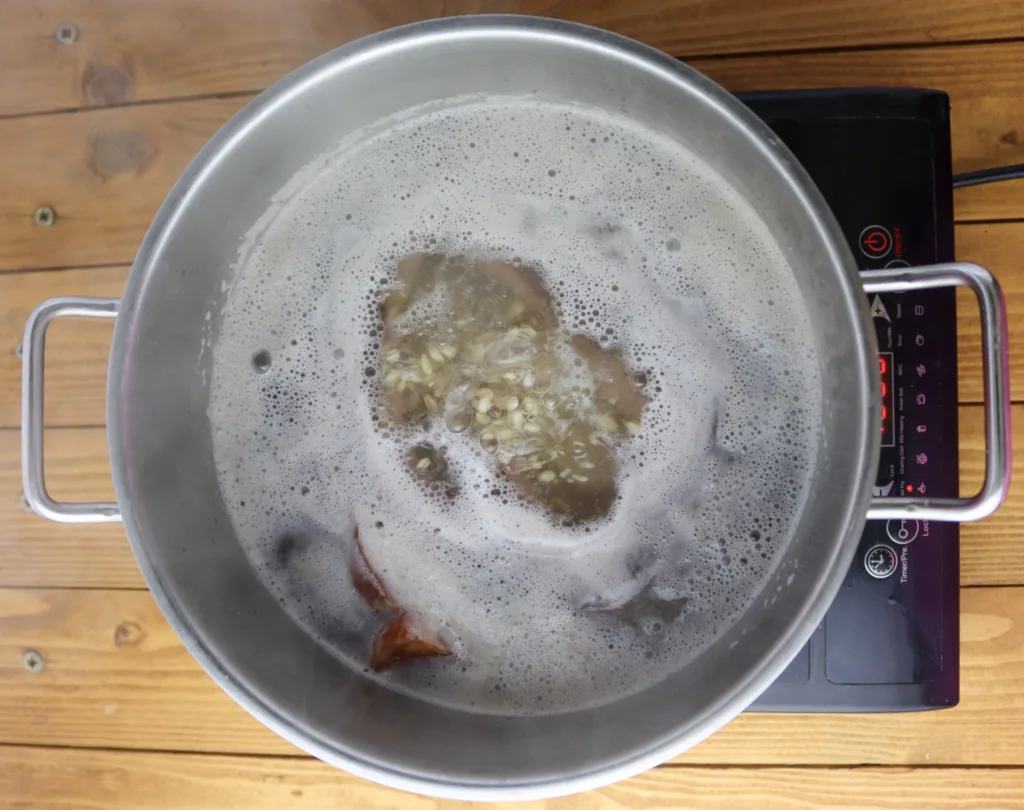
ADD VEGETABLES
STEP 5: In the meantime, while the barley and ribs are simmering, prepare the vegetables. Slice the carrots, parsley root, celery root and kohlrabi into small cubes. Also, dice the onions and garlic into pieces as small as possible.
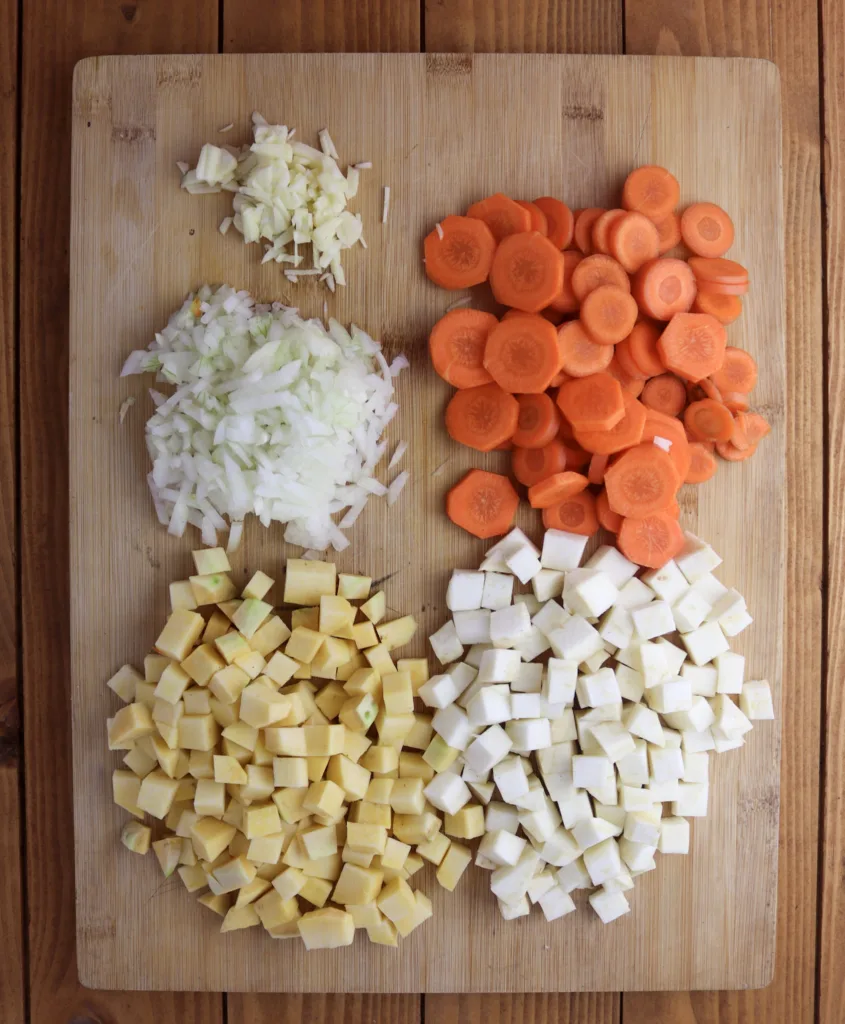
After the barley with pork ribs has been simmering for about an hour, quickly stir-fry the garlic and onions in hot lard or oil. We used olive oil in the recipe, but the traditional recipe usually called for lard, which was easily at hand in the old days.
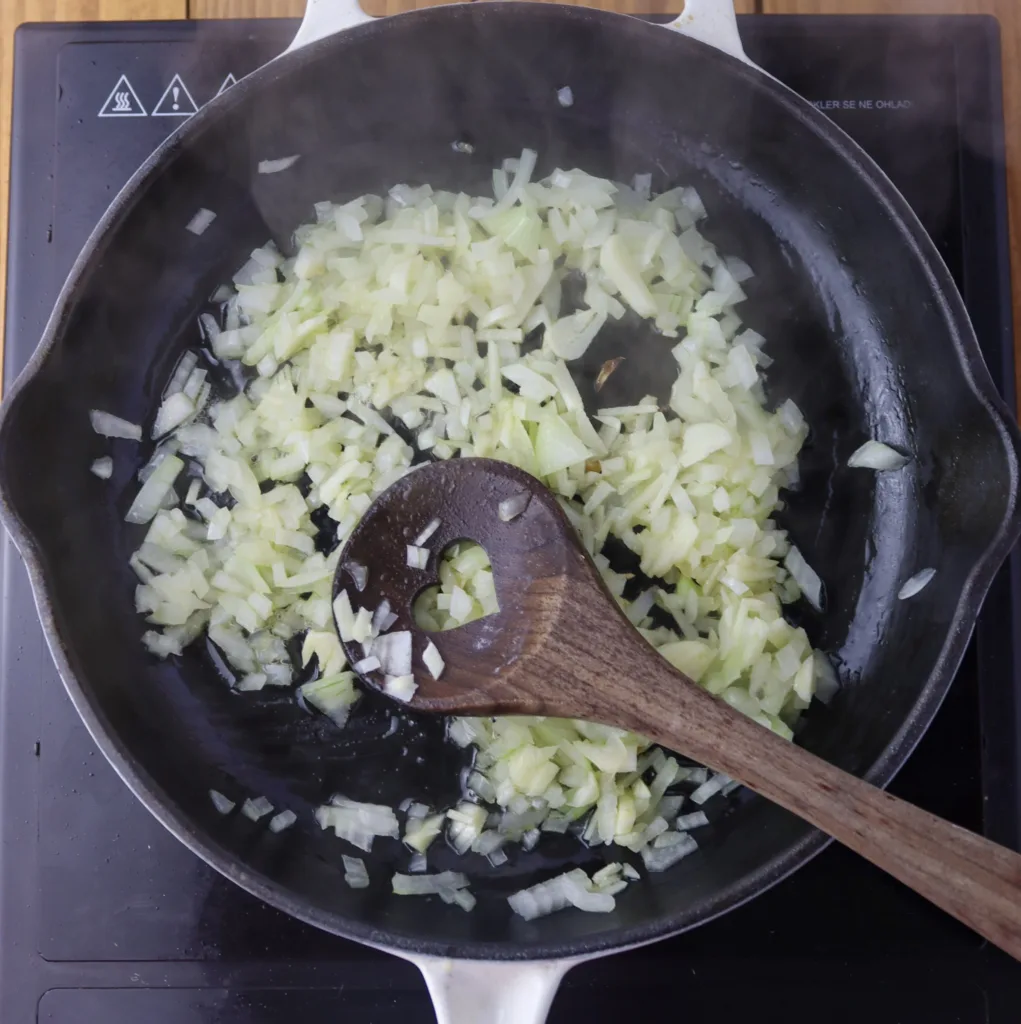
First, add the fried onions and garlic and then pieces of vegetables to the pot. Add a pinch of dried marjoram and simmer for another 20 minutes.
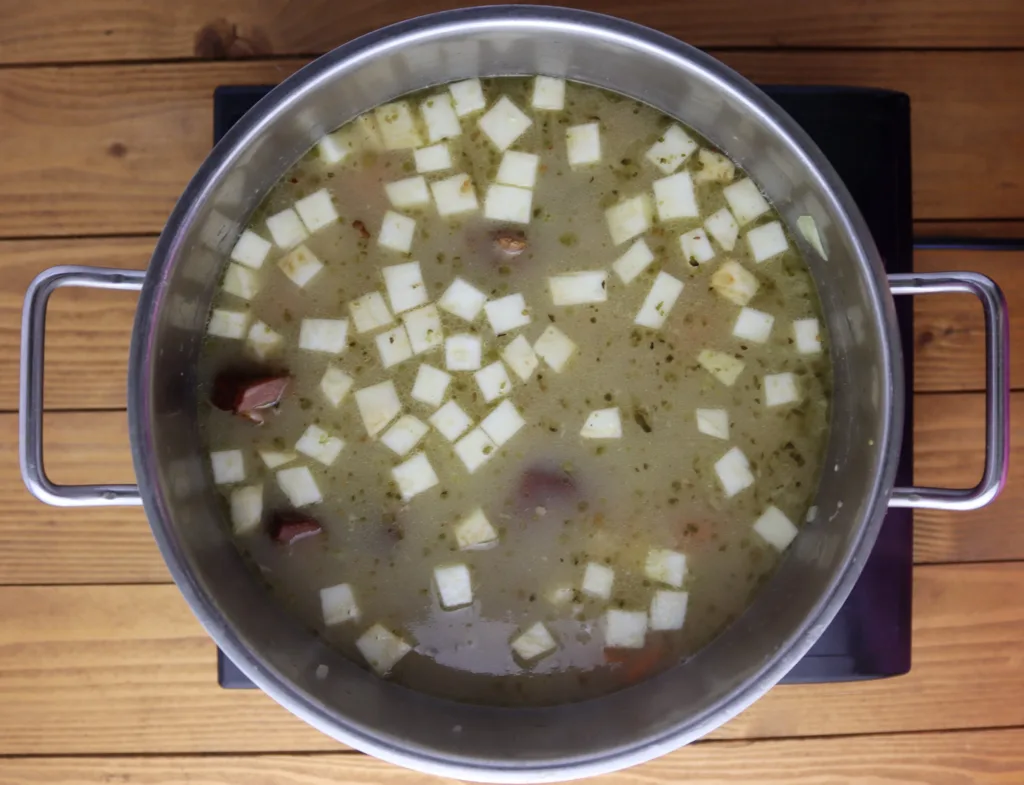
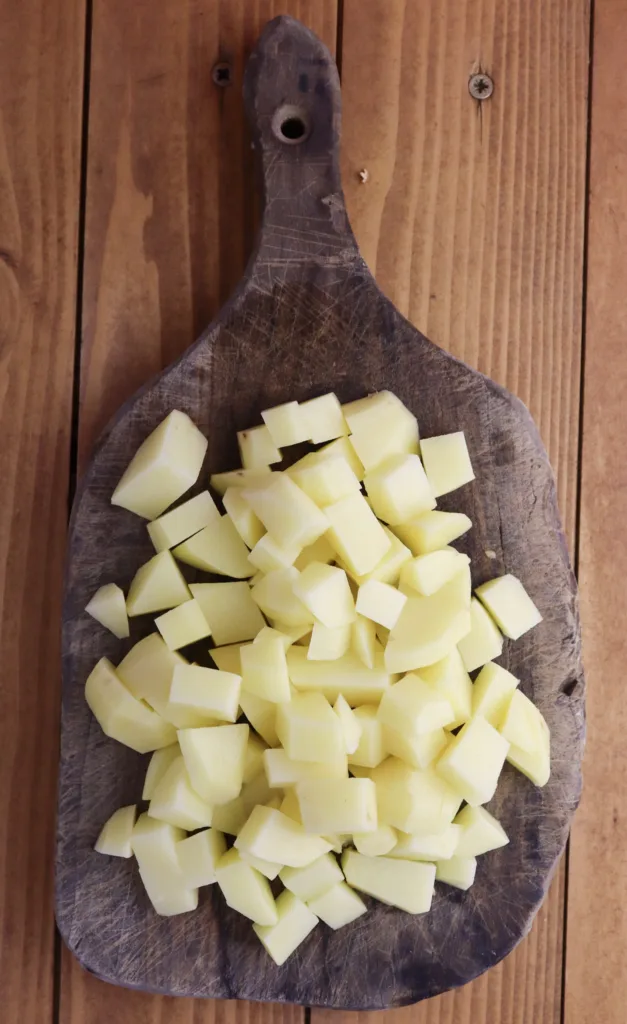
ADD POTATOES
STEP 6: Potatoes are added to the soup later because they need less cooking than the rest of the vegetables.
After the ričet was slowly simmering together with the vegetables for about twenty minutes, peel, wash, and dice the potatoes into small cubes and add them to the pot.
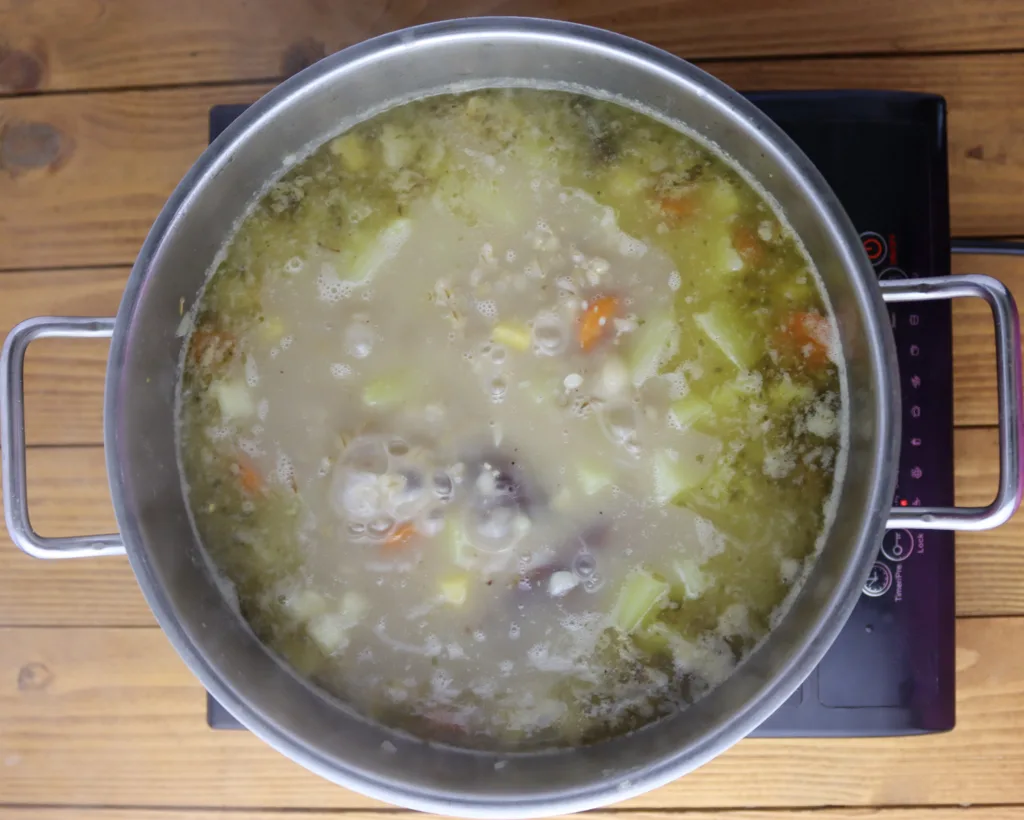
STEP 7: Slowly simmer on very low heat for another twenty minutes. At that time, the potatoes and the vegetables should be cooked.
ADD BEANS, PARSLEY AND SLICED RIBS
STEP 8: Towards the end of cooking, wash the parsley, shake the water off and chop it.
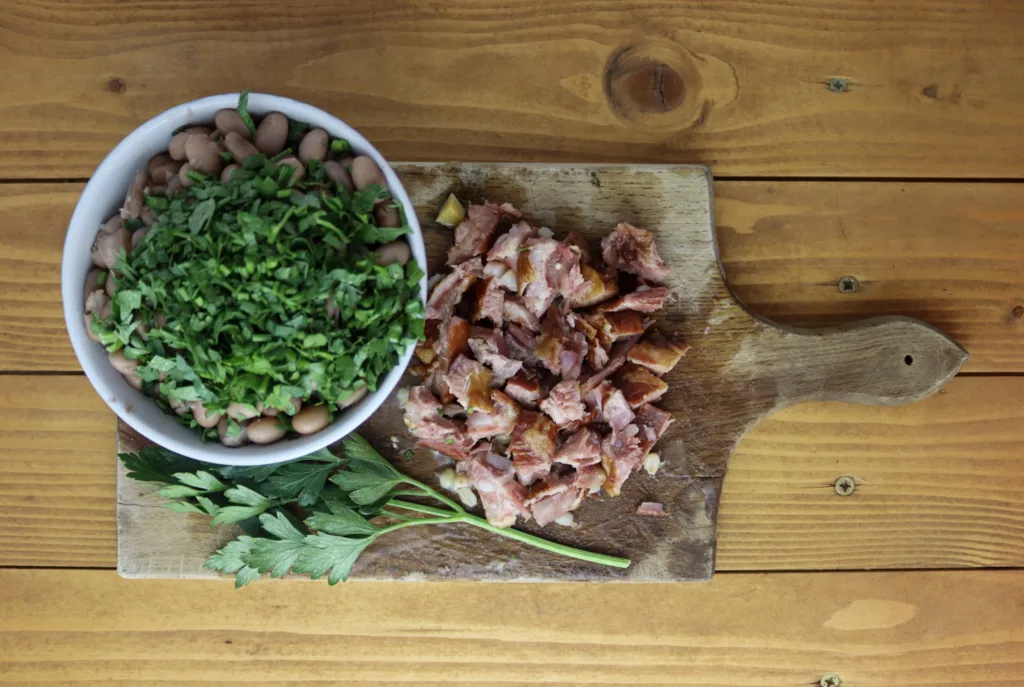
Remove a few pork ribs (or sausages, if you are using them) from the pot and slice them into smaller pieces. Also, strain cooked beans and then add them together with the chopped parsley and sliced pork ribs back to the pot.
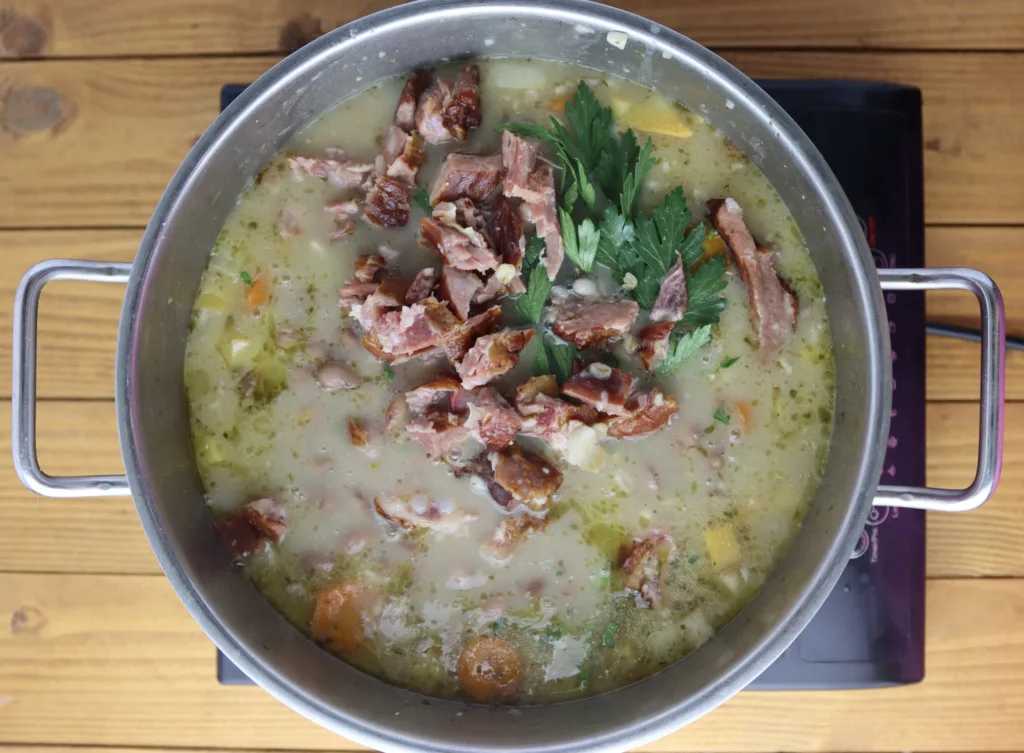
STEP 9: Simmer only for a minute longer so that the beans get warm enough. Smoked pork ribs will release quite enough salt to the soup, but at this point, you should try your delicious ričet and add more if it’s not salty enough.
In the end, add black pepper to taste. There you have it; your delicious Slovenian ricet is done!
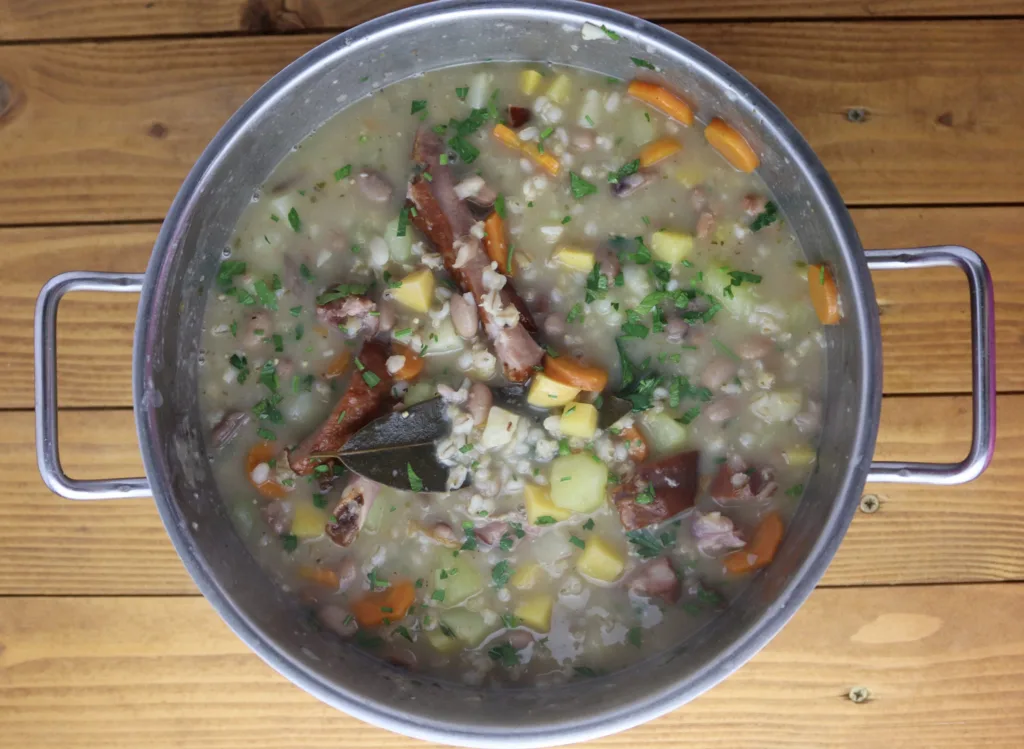
Some people love to spice up ričet by adding a tablespoon of apple vinegar to the pot right at the end of cooking. You might want to give this a try, it does combine well with other ingredients, and it tastes delicious.
Although you can serve it right away when it’s cooked, in the old days, ričet was often warmed and served with freshly baked homemade bread the next day.
That’s exactly why it was always cooked in large pots; the delicious mix of aromas in the iconic soup will get even better with each day of storage.
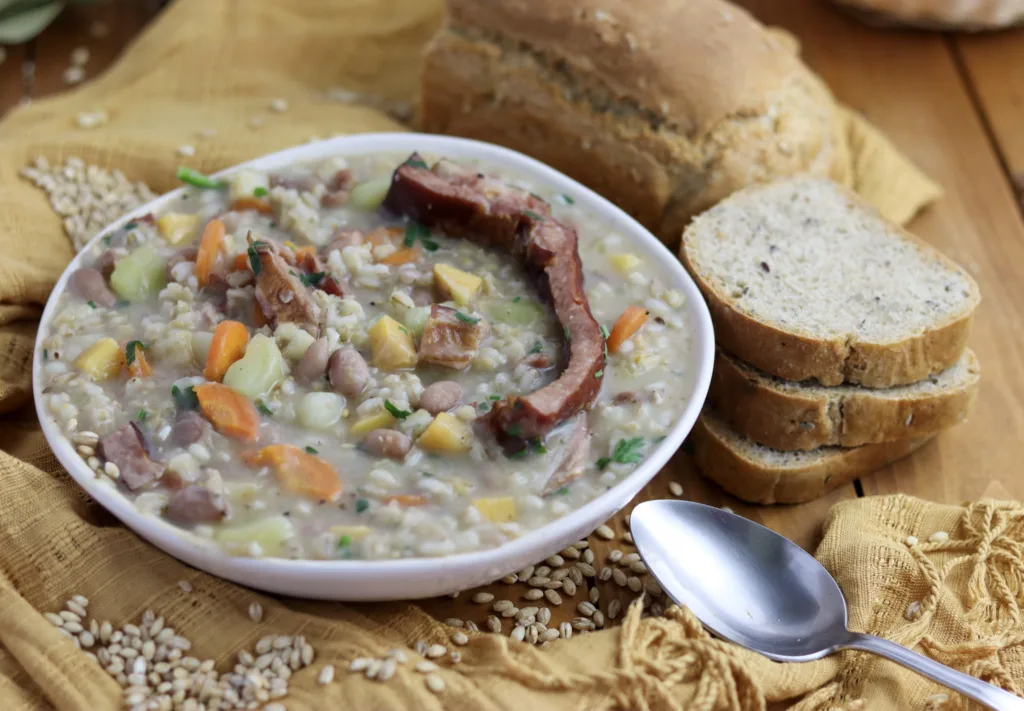
Tips for cooking the tastiest ricet
- For a perfectly tasting ričet, try to gather organic ingredients and homemade smoked meat. Ričet is a traditional soup that has combined most of the usual crops that were preserved for the winter in the old days in one pot; that’s why you shouldn’t have problems finding them at any time of year.
- Don’t spare parsley; the amount of parsley, together with parsley root, is quite high in a traditional ričet. Parsley won’t override the aromas of other ingredients; it will even enhance them. Especially parsley root will bring a slightly sweet and mildly peppery note, which nicely complements other ingredients and adds a pleasant balance to the soup.
- Prefer using dry beans over canned ones. Soaking the beans before cooking will help greatly reduce the cooking time. During soaking, oligosaccharides, which are responsible for bloating and creating gas after consuming bean dishes, will usually dissolve in the water. That’s why the water in which the beans were soaked needs to be discarded and beans rinsed under fresh water before cooking.
- Soaking the barley not only cuts down on cooking time but also guarantees a smoother texture in the end. Moreover, soaking serves the purpose of getting rid of some of the phytic acids naturally found in barley. These acids can mess with how our bodies absorb essential minerals. And as a bonus, soaking also comes to the rescue in breaking down the complex sugars in barley.
- Adding bay leaves and marjoram when cooking beans will help reduce bloating, gases and, yes, farting too.
- Keep in mind that when you wish to cook a perfect ričet, it shouldn’t be cooked on a lot of heat, but it should simmer slowly on low heat.
- Ričet tastes absolutely the best when it’s stored in the refrigerator and heated up, and served the next day. It was usually served as a complete meal with fresh homemade bread.
- For an even better and more genuine taste of ricet, add a tablespoon of homemade apple vinegar right before serving. Some people even add it separately to the bowl when it’s already served.
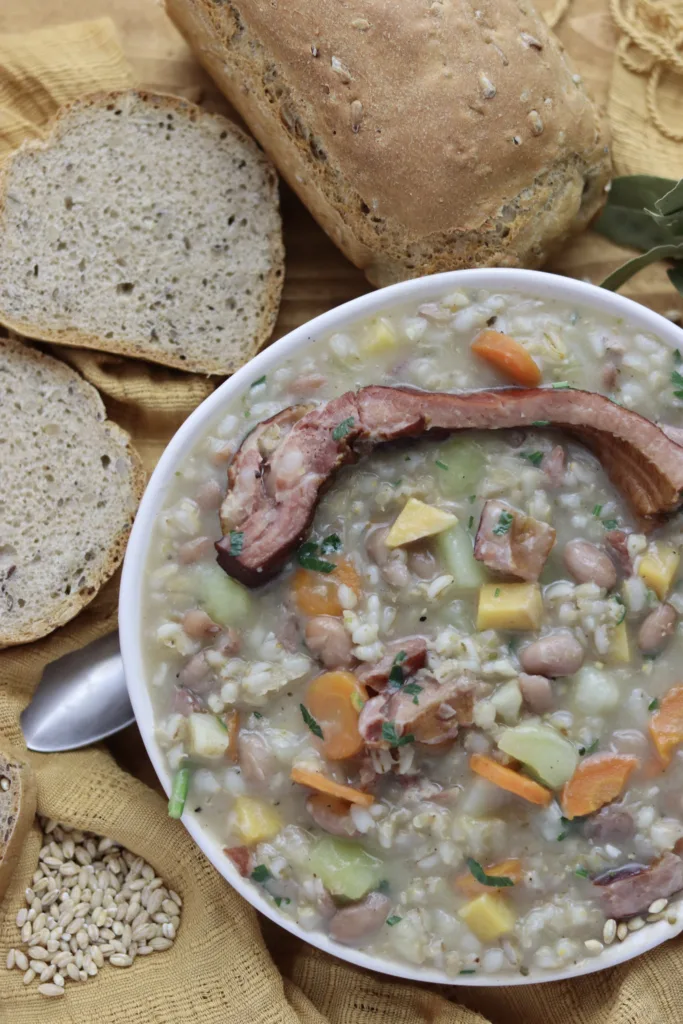
Storage and canning
Ričet can be cooked in advance and stored in the refrigerator for up to four days.
It’s best if you store it in a covered pot or container. When heating it up again, take only the amount you’re going to eat and heat it in a smaller pot.
Ričet can also be canned following the usual canning procedure. Fill up hot, sterilized jars with hot ričet up to the top and carefully seal them with sterilized lids. Place the jars turned upside down under a blanket and allow them to cool down slowly.
Canned ričet will be an extraordinarily delicious choice for lunch on your trips, mountain hikes, or just on ordinary days when you don’t have enough time for cooking.

Freezing ričet
Before freezing, allow the ričet to cool down to room temperature. It’s best to divide the soup into individual or family-sized portions. This way, you can thaw only the amount that you need.
Place the ričet into air-tight containers to prevent freezer odors from sipping in. A good reusable container that you don’t need to buy and can be re-used are ice cream packages or even plastic bags, ensuring that you squeeze out the remaining air. Leave some space at the top of the container or bag to allow for expansion as the soup freezes. This prevents containers from cracking.
Label the containers or bags with the name and date of preparing ričet to ensure eating it at the right time.
When thawing ričet, it’s best to thaw it overnight in the refrigerator or place it in a bowl of cold water to speed up the process.
Ričet can be stored in the freezer for up to six months.

Traditional ričet FAQs
Ričet can be made as a vegan variation, depending on the ingredients used to make it. However, the traditional ričet was cooked with smoked pork and onions used in ričet were often stir-fried in hot lard.
Barley porridge with hulled barley was used for traditional ričet. Barley was soaked for a few hours prior to cooking.
If you cook ričet to the traditional recipe, the soup will already be thick enough due to the barley, potatoes and other vegetables in the ričet. However, if you want your ričet to be even thicker, it’s best to add a few more diced potatoes, remove them from the pot towards the end of cooking and return them to the pot mashed.
Barley is a type of whole grain that’s packed with dietary fiber, especially with beta-glucans. These have been connected to a bunch of good health effects, like helping with cholesterol levels and keeping blood sugar in check. On top of that, barley brings in a solid dose of vitamins and minerals like B vitamins, iron, magnesium, and selenium. Another neat thing is that it has a lower glycemic index than a lot of rice varieties. That basically means it doesn’t cause a quick spike in blood sugar levels and has a gentler effect.
However, if you have specific dietary restrictions or preferences, such as following a gluten-free diet, be aware that barley contains gluten while rice is naturally gluten-free.
Regular barley porridge can be substituted for pear barley when cooking ričet, but keep in mind that pearl barley will reduce the overall time of cooking.
Yes, barley water is rich in fiber and beta-glucans, and it helps to maintain a healthy digestive system. Barley water packs in a mix of vitamins and minerals that do some pretty important jobs for your body. It contains B vitamins like niacin, thiamin, and riboflavin, which help with things like turning food into energy and keeping your immune system in check. Plus, there’s iron, magnesium, and selenium in the mix, and they all play roles in keeping your body running smoothly and feeling good.
If you want to eat traditional Slovenian ričet, head to Šmarna gora, a hill near Ljubljana in Slovenia. The place has a long history of serving ričet and other Slovenian national dishes.
More traditional Slavic recipes
Food nutter’s favorites
Tagliatelle with porcini mushrooms
Ricet
INGREDIENTS
- 0,66 lb barley porridge (300 g)
- 0,44 lb dried brown beans (200 g)
- 1,1 lb smoked pork meat – ribs, sausages or other (500 g)
- 0,88 lb potatoes (400 g)
- 2 onions
- 4 cloves garlic
- 1 middle-sized kohlrabi
- 3 fresh carrots
- 1 celery root
- 2 parsley roots
- fresh parsley
- 2 lavender leaves
- dried marjoram
- salt
- black pepper
- 1 tbsp oil or lard
INSTRUCTIONS
- The night before cooking ričet, wash the beans, soak them in double amount of water and remove any unhealthy looking beans, specialy the ones that are floating on the water.
- Three hours before cooking, soak the barley as well.
- In the morning, wash the beans, place them in a pot with fresh water together with the lavender leaf and cook until they soften and become tender, which usually happens in an hour.
- Transfer the barley together with the water to a bigger pot, add smoked pork ribs and cover with water. All the ingredients should be generously covered with water. Bring to boil and simmer slowly for an hour.
- In the meantime, dice the vegetables to small pieces and cut the onions and garlic.
- After the barley and ribs were simmering for an hour, quickly stir-fry the onions and garlic and add them together with the diced vegetables to the pot. Simmer for another twenty minutes. Add a pinch of marjoram.
- Now add the diced potatoes and simmer for another 15-20 minutes.
- Remove a portion of pork ribs from the pot and slice it into smaller pieces. Return it to the pot together with chopped parsley leaves and cooked beans with lavender leaves.
- Before serving, try to see if your ričet is salty enough and add additional salt and black pepper if needed. If you like the taste, add a tbsp of apple vinegar.
- Serve with fresh, homemade bread and enjoy 🙂
Video
NOTES
- For best quality, use organic ingredients, dry beans and homemade smoked pork.
- Ričet should simmer very slowly on low heat.
- Add a decent amount of chopped parsley leaves and parsley root.
- Soaking beans before cooking cuts down on cooking time. This step also partially gets rid of the stuff that causes bloating and gas after eating beans, which usually dissolve in the water. That’s why you should toss out the soaked water and rinse the beans before cooking.
- Soaking the barley not just trims cooking time but also ensures a smoother final texture. Plus, soaking helps reduce the natural phytic acid content in barley, which can interfere with our body’s absorption of crucial minerals. On top of that, soaking also steps in to break down the complex sugars in barley.
- Including bay leaves and marjoram while cooking beans can aid in decreasing bloating, gas, and farting due to the amount of beans in the ričet.
- Your ričet bowl will taste best when stored in the refrigerator and served the next day. Each day of storage will add to its deliciousness.
- Add salt and black pepper right before serving. If you like the taste, add a tablespoon of apple vinegar and serve with fresh homemade bread.
- Ričet can be stored in the refrigerator for up to four days. You can freeze it in air-tight containers for up to six months or make canned ričet following a simple canning procedure.
Nutrition
Have you tried the traditional ričet bowl? Please rate it in the comments below.
Share with love ❤️

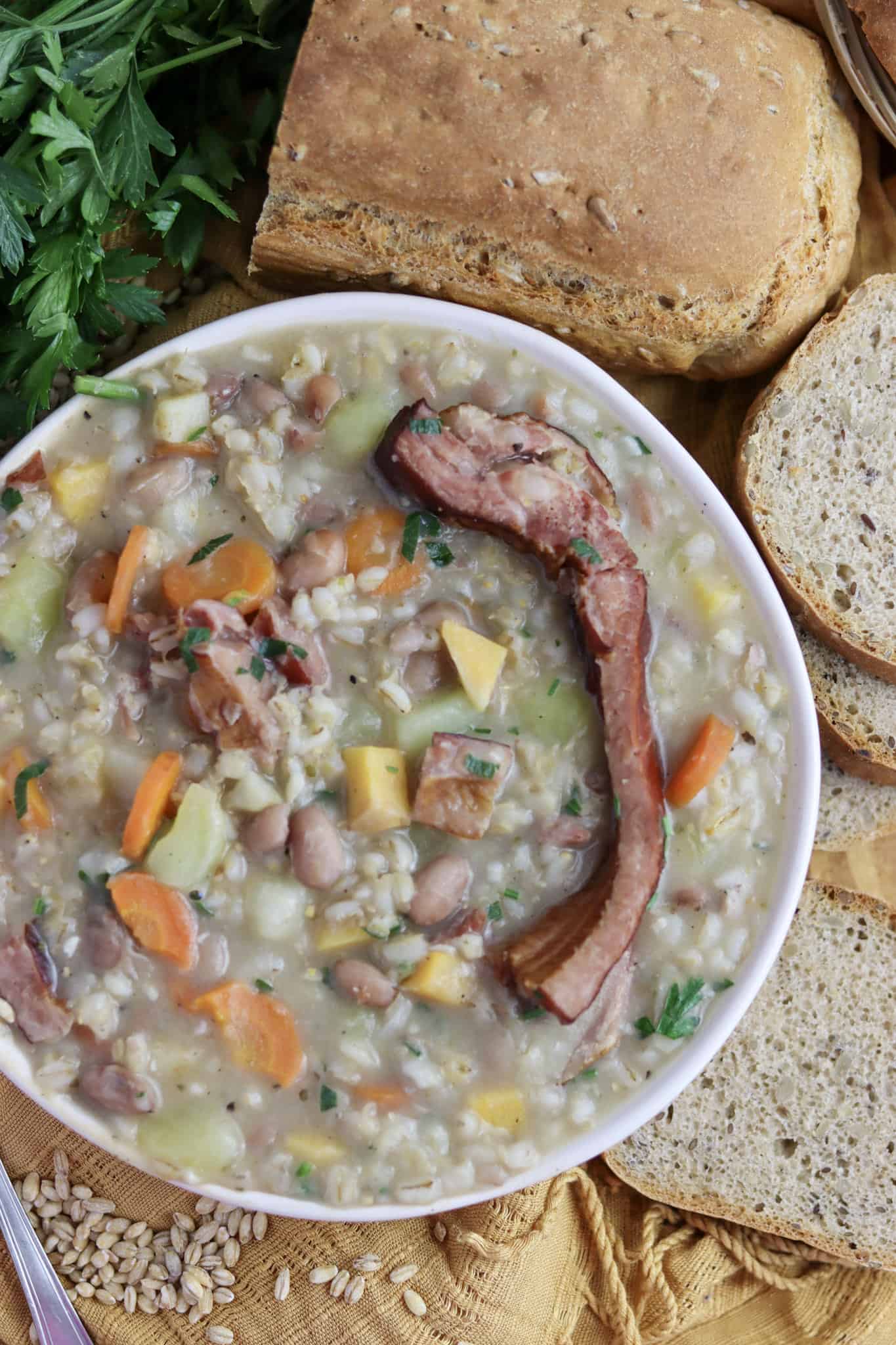

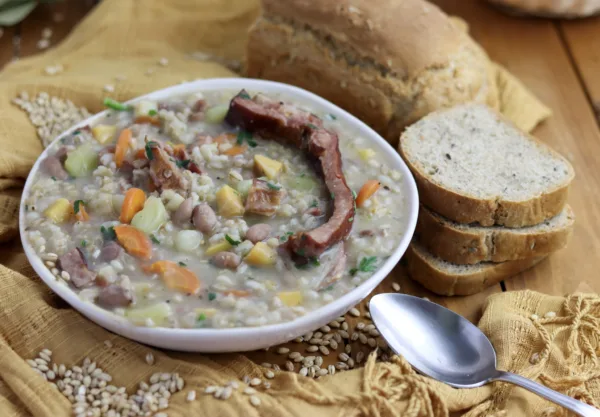
This looks so delicious, I can’t believe this dish has such an incredible history.
Thanks Jerry, indeed the story behind the soup is amazing.
Amazing, love a thick and hearty soup and this one does fit that bill, especially with the rice and the pork. Pinned it
Thank you for sharing your links with us at #275 SSPS Linky. See you again next week
Thanks Esme, but it’s not rice, it’s cooked with barley porridge.
Ooo. This sounds good. Bookmarking so I can try later.
Visiting today from PoCoLo #10&11
Thanks Paula!
Hi Amanda, I don’t think you can find a real substitute for celeriac and parsley root, but it will still taste great if you add more parsley and celery leaves.
I love your introduction!! Food is such an integral part of our history, both culturally and personally. You have made it sound so amazing I want to give it a try. Thank you for sharing at the What’s for Dinner party – I hope your week goes absolutely wonderfully.
Thanks Helen! Ricet is trully an extraordinary dish and there is so much history behind it. I don’t think there’s a Slovenian who wouldn’t eat it and no other food can beat ricet served in the moutain huts.
Thanks for the information here.
I may try this as a vegetarian dish. I know it won’t be authentic, but it sounds lovely.
Thanks for linking up at the Sunday Sunshine Blog Hop 76!
Laurie
Please do, the vegetarian version tastes just as great as the one with smoked meat.
My husband will love this recipe.
Thanks for linking with #pocolo
I’m happy to hear that, hope you’ll both enjoy it.
This soup looks delicious. I’m going to save this and prepare it soon. Thank you for sharing.
Thanks Steph 🙂
If someone didn’t like pork, what would you recommend they swap it with? A family member of mine doesn’t like it, but I want to try this so bad!
Hi Carly, I wouldn’t swap it for anything but actually just skip it, the vegetarian version is surprisingly tasteful!